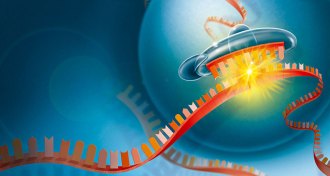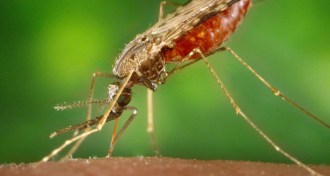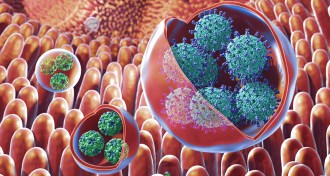News
-
 Animals
AnimalsIn the animal kingdom, what does it mean to be promiscuous?
A review of hundreds of scientific studies finds that the label “promiscuous” is applied to a surprisingly wide range of mating behaviors in animals.
By Betsy Mason -
 Health & Medicine
Health & MedicineThe first gene-silencing drug wins FDA approval
The FDA just approved the first drug that works via RNA interference.
-
 Astronomy
AstronomyA faint glow found between galaxies could be a beacon for dark matter
Intracluster light may help reveal where dark matter resides within galaxy clusters.
-
 Health & Medicine
Health & MedicinePregnant women’s use of opioids is on the rise
The rate of opioid use during pregnancy more than quadrupled in 28 U.S. states, prompting physicians to call for increased screening.
-
 Animals
AnimalsA ghost gene leaves ocean mammals vulnerable to some pesticides
Manatees, dolphins and other warm-blooded marine animals can't break down organophosphates due to genetic mutations that occurred long ago.
-
 Health & Medicine
Health & MedicineA newly approved drug could be a boon for treating malaria
Tafenoquine could help prevent the recurring form of malaria, but the drug may also be dangerous for people who have a certain genetic mutation.
-
 Astronomy
AstronomyNew Horizons may have seen a glow at the solar system’s edge
New Horizons may have seen a hydrogen wall just past the edge of the solar system, where the solar wind meets the stuff of interstellar space.
-
 Genetics
GeneticsResearchers say CRISPR edits to a human embryo worked. But critics still doubt it
Researchers say that they have confirmed CRISPR/Cas9 edits of a heart disease–causing version of a gene, but critics still have doubts.
-
 Archaeology
ArchaeologyThe debate over people’s pathway into the Americas heats up
Defenders of an ice-free inland passage for early Americans make their case.
By Bruce Bower -
 Earth
EarthGlobal dimming may mitigate warming, but could hurt crop yields
Injecting a veil of tiny particles into the atmosphere might reduce global warming, but it could also lower crop yields.
-
 Life
LifeNasty stomach viruses can travel in packs
Contained clusters of rotavirus and norovirus caused more severe infections in mice than the same viruses working solo.
-
 Health & Medicine
Health & MedicineZika may harm nearly 1 in 7 babies exposed to the virus in the womb
A new CDC report tallies neurological and developmental problems, in addition to birth defects, possibly due to Zika in U.S. territory–born babies.